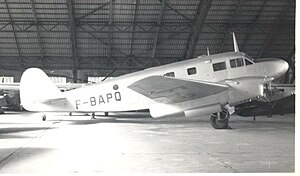Caudron C-440
| C.440 Goéland | |
|---|---|
 |
|
| Caudron C.449 Goeland trainer of Air France at Pontoise-Cormeilles airfield near Paris in May 1957 | |
| Role | Civil utility aircraft |
| Manufacturer | Caudron |
| Designer | Marcel Riffard |
| First flight | 1934 |
| Number built | 1,702 |
The Caudron C.440 Goéland ("seagull") was a six-seat twin-engine utility aircraft developed in France in the mid-1930s.
It was a conventionally configured low-wing cantilever monoplane with tailwheel undercarriage. The main undercarriage units retracted into the engine nacelles. Construction was wooden throughout, with wooden skinning everywhere but the forward and upper fuselage sections, which were skinned in metal. As usually configured, the cabin seated six passengers with baggage compartments fore and aft, and a toilet aft.
Apart from private buyers, the C.440 was also bought by the Armée de l'Air, Aéronavale, Aéromaritime, Régie Air Afrique and Air France, and some were exported for service with Aeroput. Production of the C.440 and its subtypes continued until the outbreak of World War II, at which time many C.440s were impressed into military service. Following the fall of France, some were operated by the German Luftwaffe and Deutsche Luft Hansa. Another user was the Slovenské vzdušné zbrane - it ordered 12 aircraft as the C.445M in 1942.
Production was restarted following the war for both military and civil use as a transport and as a twin-engined trainer. In the postwar reorganisation of the French aircraft industry, Caudron became part of SNCA du Nord, and the aircraft became the Nord Goeland; 325 of these were built. Postwar commercial operators included Air France, SABENA, Aigle Azur, and Compagnie Air Transport (CAT).
General characteristics
...
Wikipedia
